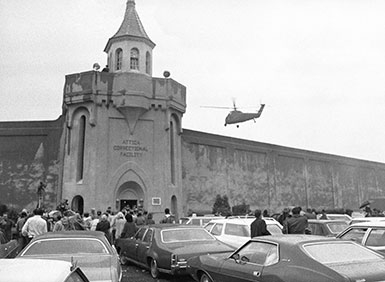NYU Law and the Attica prison uprising, 50 years later
Fifty years ago, in September 1971, an inmates’ uprising at New York State’s Attica Correctional Facility constituted a milestone in the push for prisoners’ rights. More than half of the men incarcerated at Attica took control of large parts of the prison and demanded more humane conditions. Four days of negotiation ensued, but ultimately Governor Nelson Rockefeller and Commissioner of Corrections Russell Oswald decided that state police would retake Attica by force. During a chaotic surprise operation on September 13 that lasted six minutes, law enforcement shot more than 120 men, resulting in the deaths of 10 hostages and 29 incarcerated persons.
In the aftermath of the uprising, members of the NYU Law community took leading roles in addressing injustices perpetrated at Attica. Robert McKay, NYU Law’s dean from 1967 to 1975, chaired the New York State Special Commission on Attica. Meanwhile, several alumni represented Attica inmates in the criminal proceedings and other litigation that followed.
Daniel Alterman ’69, LLM ’71 recalls being one of the first lawyers permitted to enter Attica on September 17 through his involvement with the National Lawyers Guild (NLG). Officials had refused to allow anyone inside for days. Alterman, acting as an interviewer and observer, found prisoners with bleeding wounds who were not receiving medical attention. “It was a pretty heavy scene,” he says, adding that, meanwhile, the state was lying about how the victims had died.
Legal Aid Society lawyer Phylis Skloot Bamberger ’63 and another colleague persuaded a three-judge panel of the US Court of Appeals for the Second Circuit to order an immediate halt to the severe abuse guards were inflicting on inmates in the wake of the uprising. Martin Stolar ’68 coordinated the recruitment of lawyers under NLG’s auspices to offer legal services to the Attica inmates. After dozens of inmates were indicted in connection with the uprising, Stolar helped organize lawyers nationwide to represent them and took on one case himself, making a successful motion to dismiss in the interest of justice. Alterman recalls defending an Attica inmate in 1975 in a kidnapping case that his former boss from South Brooklyn Legal Services, where Alterman had worked as a Reginald Heber Smith Community Lawyer Fellow, asked him to take over. It was Alterman's first criminal trial. “I didn’t know what the f--- I was doing,” he says. But the three-month trial ended in an acquittal.
Stolar worked with other attorneys to draft a civil complaint against Rockefeller and other officials involved with the Attica response. They filed a class action in 1974. The matter would not be resolved for decades. In 2000, Judge Michael Telesca of the US District Court for the Western District of New York divided an $8 million settlement among more than 500 former inmates and their relatives.
“I thought I knew about racism and racism in the criminal justice system and racism in our society,” Stolar says. “I had a whole new lesson learned in the Attica experience.”
Both Alterman and Stolar praise the efforts of the late civil rights activist W. Haywood Burns, an adjunct professor who eventually joined the NYU Law faculty. After Attica, Burns served as the national coordinator of the inmates’ legal defense. Burns was “brilliant,” Alterman remembers, for allowing the defendants to help define the political issues around the prison conditions and killings at Attica.
A year after the uprising, in September 1972, the commission chaired by McKay released a 500-page report that was highly critical of both Rockefeller and state prison authorities. The report’s preface stressed that the conditions leading to the Attica uprising were hardly unique to that penal institution: “In capturing that moment we have examined state rules and procedures, prison politics, the changing nature of the inmate population, and festering racism—a dangerously volatile mix. That the explosion occurred first at Attica was probably chance. But the elements for replication are all around us. Attica is every prison; and every prison is Attica.”
Half a century after the Attica uprising was violently quashed, Stolar reflects on its impact. “Did Attica make a difference? It should have,” he says. “I’m afraid it didn’t. It caused some minor reforms, but certainly even with the basic questions it raised, it hasn’t done what it should have done. It’s still a cry for reform, for really looking at what the nature of prisons is and what they do and who’s incarcerated there.”
On September 29, 2021, NYU Law’s Center on Race, Inequality, and the Law will host “Commemorating Attica,” an online event featuring Daniel Alterman ’69, LLM ’71; Martin Stolar ’68; and others connected to the Attica uprising.
Posted September 27, 2021


